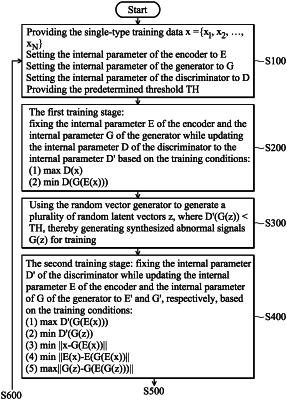| CPC G06N 3/08 (2013.01) [G06F 16/2365 (2019.01); G06N 3/045 (2023.01)] | 15 Claims |

|
1. An anomaly detection device based on a generative adversarial network architecture, wherein the anomaly detection device uses single-type training data composed of a plurality of normal signals to train an anomaly detection model, the anomaly detection device comprising:
an encoder, configured to encode an input signal into an output latent vector;
a generator, connected to the encoder, wherein the generator is configured to generate a synthesized signal using an input latent vector, and the synthesized signal has a same dimension as the plurality of normal signals;
a discriminator, connected to the generator, wherein the discriminator is configured to determine whether the input signal is real or fake and output a discriminant value; and
a random vector generator, configured to generate a plurality of random latent vectors;
wherein the anomaly detection model training comprises a first training stage and a second training stage, the random latent vectors are sequentially input to the generator to generate a plurality of synthesized signals with the same dimension as the plurality of normal signals, each one of the plurality of synthesized signals is input in sequence into the discriminator to output the discriminant value corresponding to that synthesized signal, and one or more of the plurality of synthesized signals that correspond to the discriminant value below a predetermined threshold are selected as training synthesized abnormal signals;
wherein when the discriminator is trained in the first training stage, a plurality of internal parameters of the encoder and the generator are fixed, and the plurality of normal signals from the single-type training data are sequentially input into the encoder to output a plurality of first latent vectors that correspond to the plurality of normal signals, and then the plurality of first latent vectors are input into the generator, so as to generate a plurality of first reconstruction signals that correspond to the plurality of first latent vectors;
wherein the encoder and the generator are trained in the second training stage while the plurality of internal parameters of the discriminator are fixed, and the plurality of first reconstruction signals are sequentially input into the encoder to output a plurality of second latent vectors, then each one of the training synthesized abnormal signals is input into the encoder to output a plurality of third latent vectors, and the plurality of third latent vectors are input into the generator to generate a plurality of second reconstruction signals; and
wherein a first error value is calculated by accumulating a distance value between each of the plurality of normal signals and the first reconstruction signal corresponding to that normal signal, a second error value is calculated by accumulating the distance value between each of the first latent vectors and the second latent vector corresponding to that first latent vector, and a third error value is calculated by accumulating the distance value between each of the training synthesized abnormal signals and the second reconstruction signal corresponding to that training synthesized abnormal signal.
|